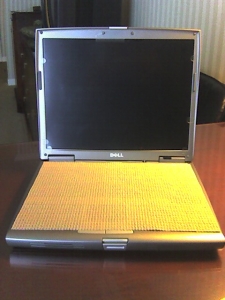For quite some time I've used a 3M Privacy Filter for my laptop screen. It keeps prying eyes from my seatmates away (useful when I'm doing things like studying budgets, dealing with personnel reviews, etc. on planes).
The problem is that these privacy filters get scratched up over time since they rub up against my laptop keyboard (to a lesser degree, my laptop screen got keyboard-shaped scratches and wear marks even before I used the privacy screen).
Last year, I came up with a lifehack that helps prevent this.  I used that rubberized shelf liner stuff to make a pad to go between my keyboard and the screen. It not only adds a bit more cushion to protect the screen, it also prevents those scratches (click the picture for an enlarged view).
I used that rubberized shelf liner stuff to make a pad to go between my keyboard and the screen. It not only adds a bit more cushion to protect the screen, it also prevents those scratches (click the picture for an enlarged view).
- Pick a color that coordinates with your laptop, so you can be truly fashionable.
- Cut a rectangular section to fit within the outer bounds of your screen (you can use scissors for this, or I like to use the paper cutter at my office).
- Place it in between the keyboard and the screen when you close your laptop.
Voila - you prolong the life of your screen at a very low cost.
By the way - I previously had a black sheet of this, but I lost several of them because I'd forget about them on dark planes. I switched to the lighter shade you see in the picture and haven't lost one in a while.
Read More


